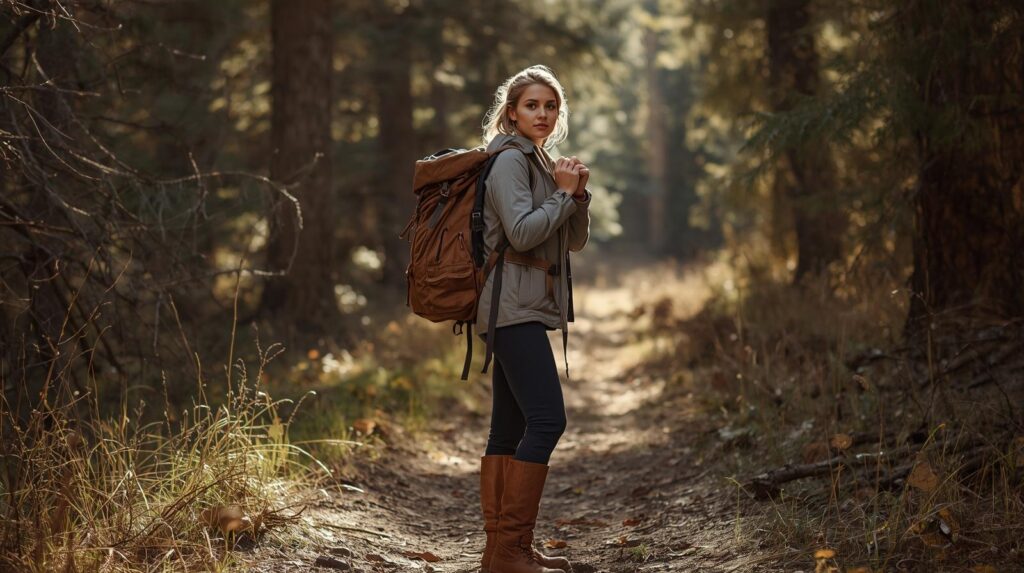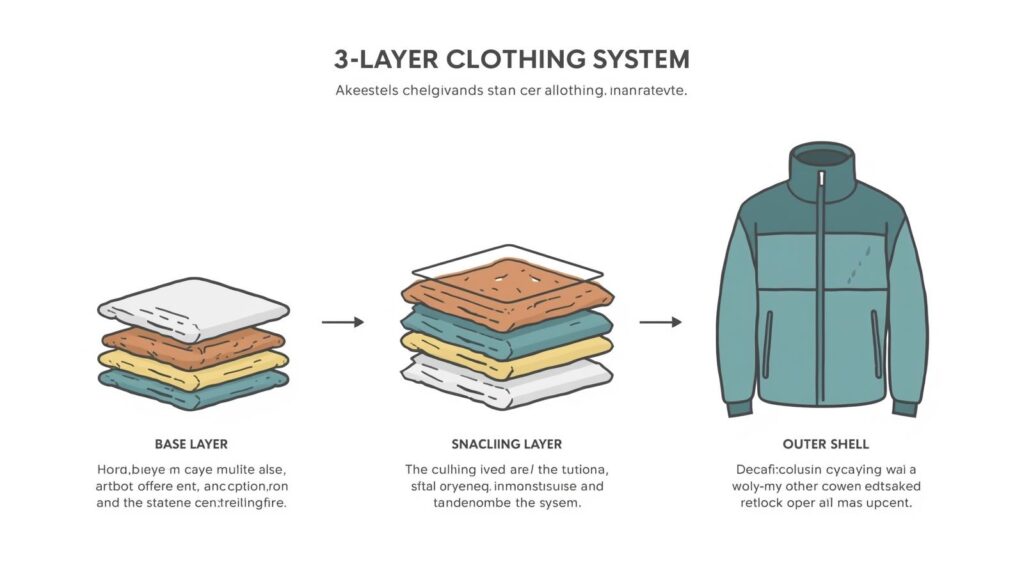Standing at the trailhead last spring, I watched a group of hikers turn back after just thirty minutes. Their cotton t-shirts were soaked through, their jeans chafing, and their sneakers sliding on wet rocks. That moment reminded me why understanding what to wear hiking can make or break your outdoor adventure.
The hiking apparel market tells this story better than words ever could. The global hiking gear and equipment market reached $5.97 billion in 2024, with clothing representing 49.7% of total market share. This massive investment reflects what experienced hikers have always known: proper clothing isn’t just about comfort it’s about safety, performance, and enjoying every moment on the trail.
With more than 61 million Americans participating in hiking in 2023 representing an 89% growth since 2010 more people than ever are asking the same question: what clothes to wear for hiking? This guide will answer that question comprehensively, whether you’re planning a casual day hike or preparing for a multi-day backcountry expedition.

Understanding the Three-Layer System
When deciding what to wear hiking, the three-layer system forms the foundation of effective trail clothing. This time-tested approach has evolved into an industry standard for a reason it works in virtually every condition.
The base layer sits against your skin, managing moisture and regulating temperature. Your mid-layer provides insulation, trapping warm air close to your body. The outer layer shields you from wind, rain, and snow while allowing moisture to escape. Together, these three components create a versatile system that adapts to changing conditions.
Modern fabric technology has revolutionized what to wear hiking. Brands are producing jackets with insulation and waterproof capabilities using lightweight, moisture-wicking, and breathable materials. These innovations mean you can carry less weight while staying more comfortable a game-changer for serious hikers.
Base Layer Essentials
Your base layer deserves careful consideration when planning what to wear hiking. This crucial first layer manages sweat, prevents chafing, and maintains body temperature throughout your adventure.
Merino wool and synthetic fabrics dominate the base layer market for good reason. Merino wool naturally regulates temperature, resists odor, and feels soft against skin. Synthetic options like polyester dry faster and typically cost less. Both choices dramatically outperform cotton, which retains moisture and can lead to hypothermia in cold conditions.
For your torso, choose long-sleeve or short-sleeve shirts depending on season and sun exposure. Long sleeves offer better sun protection and insect defense. Bottoms should fit comfortably without restricting movement look for flatlock seams that prevent chafing during long miles.
Consider fit carefully when selecting what to wear hiking for your base layer. Too tight restricts movement; too loose creates friction. The fabric should lie smooth against your skin with enough stretch for full range of motion.
Mid-Layer Options

The mid-layer answers the critical question of what to wear hiking in variable temperatures. This insulating layer traps warm air while remaining breathable enough to prevent overheating during exertion.
Fleece jackets remain the classic mid-layer choice. Lightweight fleece works for mild conditions, while heavyweight versions handle serious cold. Synthetic insulated jackets offer excellent warmth-to-weight ratios and maintain insulation even when damp. Down jackets provide maximum warmth for their weight but lose effectiveness when wet.
Your activity level determines appropriate mid-layer thickness. High-output activities like steep climbs generate more body heat, requiring lighter insulation. Rest breaks and summit stops call for additional warmth. Many experienced hikers carry their mid-layer in their pack, adding it only when needed.
When considering what clothes to wear for hiking, remember that your mid-layer should layer smoothly under your outer shell without creating bulk or restricting arm movement. Test your layering system before hitting the trail.
Outer Layer Protection
Understanding what to wear hiking for weather protection could save your life. Your outer layer also called a shell provides your first defense against rain, wind, and snow while allowing perspiration to escape.
Waterproof-breathable fabrics represent the gold standard for hiking shells. These membranes block external moisture while allowing water vapor from sweat to escape. Gore-Tex and ripstop nylon provide superior protection from elements while minimizing weight. Quality shells include sealed seams, adjustable hoods, and pit zips for ventilation.
Softshells offer a middle ground between fleece and hardshells. These stretchy, breathable jackets resist light precipitation while providing better mobility and comfort than traditional rain jackets. They work brilliantly for dry conditions with variable temperatures.
Your outer layer selection depends on typical weather patterns in your hiking areas. Pacific Northwest trails demand robust waterproofing. Desert hiking prioritizes wind resistance and breathability over rain protection.
Hiking Pants and Shorts
Determining what to wear hiking from the waist down significantly impacts trail comfort. Your lower body clothing choice affects everything from temperature regulation to freedom of movement to protection from brush and insects.
Convertible hiking pants offer maximum versatility. Zip-off legs transform long pants into shorts, adapting to changing temperatures without requiring a clothing change. Standard hiking pants in synthetic fabrics provide excellent durability, quick drying, and sun protection.
Hiking shorts work brilliantly in warm weather, offering superior ventilation and reduced weight. Look for options with multiple pockets, stretchy fabric, and reinforced areas prone to wear. Some hikers prefer shorts with built-in liner briefs for additional comfort.
When considering what to wear hiking on your legs, avoid jeans and cotton pants. These materials chafe, dry slowly, and offer poor temperature regulation. Synthetic or nylon hiking pants remain the superior choice for serious trail time.
Footwear Fundamentals
Asking what to wear hiking inevitably leads to footwear discussions. Your shoes or boots represent perhaps the single most important clothing decision you’ll make for trail adventures.
Trail runners have gained massive popularity among hikers. These lightweight shoes offer excellent traction, quick drying, and superior comfort on maintained trails. They work brilliantly for day hiking and fast-packing adventures. However, they provide less ankle support and protection than traditional boots.
Hiking boots deliver maximum ankle support, protection, and durability. Mid-height boots stabilize ankles on rough terrain while full-height boots handle extreme conditions and heavy loads. Modern hiking boots weigh significantly less than earlier versions while maintaining durability.
The terrain dictates appropriate footwear. Smooth, maintained trails suit trail runners perfectly. Rocky, uneven paths favor hiking boots. Sock selection matters equally synthetic or wool hiking socks prevent blisters while providing cushioning and moisture management.
Seasonal Considerations
Understanding what to wear hiking across different seasons requires adapting your clothing system to specific conditions. Each season presents unique challenges that demand thoughtful preparation.
Spring Hiking Attire
Spring weather creates unpredictable conditions. Layer your clothing to accommodate temperature swings from morning chill to afternoon warmth. Pack your rain shell spring showers arrive without warning. Consider gaiters for muddy, wet trails.
Summer Hiking Clothes

Hot weather hiking demands careful consideration of what to wear hiking to prevent overheating while protecting from sun. Lightweight, light-colored clothing reflects heat while covering skin prevents sunburn. Breathable fabrics with UPF sun protection work brilliantly.
In 2023, outdoor recreation participants grew to 175.8 million Americans, representing 57.3% of people aged six and older. This surge in summer hiking activity underscores the importance of proper warm-weather clothing.
Fall Trail Clothing
Autumn hiking requires versatile layering. Morning temperatures often hover near freezing while afternoon sun warms significantly. Your mid-layer becomes essential for fall comfort. Waterproof protection guards against surprise storms.
Winter Hiking Gear
Cold weather demands your complete three-layer system. Insulated pants or shell pants over base layers protect your legs. Insulated, waterproof boots with aggressive tread handle snow and ice. Don’t forget winter accessories gloves, warm hat, and neck gaiter prevent dangerous heat loss.
Essential Accessories
Beyond the basics of what to wear hiking, specific accessories enhance comfort and safety. These often-overlooked items make significant differences during long trail days.
Head Protection
A hat provides crucial sun protection during summer hiking while preventing heat loss in cold conditions. Wide-brimmed hats shield face and neck from intense sun. Warm beanies retain body heat when temperatures drop. Many hikers carry both options.
Hand Coverage
Gloves protect hands from cold, sun, and rough terrain. Lightweight gloves work for cool mornings while insulated options handle serious cold. Consider glove liners for extreme conditions they add warmth while maintaining dexterity.
Neck and Face
Buffs and neck gaiters serve multiple purposes. They protect your neck from sun, provide warmth in cold, convert to headbands, and filter dust on dry trails. These versatile accessories take minimal pack space.
Eye Protection
Sunglasses protect eyes from harmful UV rays while reducing glare and eye strain. Choose sunglasses with 100% UV protection and secure fit. Consider retainer straps for rough terrain.
Hiking Clothing Statistics and Market Trends
The data behind what to wear hiking reveals fascinating trends in the outdoor apparel industry. These statistics help hikers make informed decisions about gear investments.
| Market Segment | 2024 Value | 2033 Projection | CAGR | Notes / Highlights |
|---|---|---|---|---|
| Global Hiking Apparel | $3.5B | $7.0B | 3.7% | Strong global growth expected |
| North America Market Share | 62.6% | — | — | Dominant regional market |
| Clothing Segment Share | 49.7% | — | — | Largest product segment |
| Online Sales Growth | — | — | 6.3% | E-commerce sales growing steadily |
The hiking gear clothing segment held nearly half of total market revenue in 2024, driven by increasing participation in outdoor activities and demand for specialized apparel. This substantial market share reflects how seriously modern hikers take their clothing choices.
Consumer spending patterns reveal interesting insights about what to wear hiking. Mass-priced camping and hiking gear accounted for 72.5% of revenue in 2023, while premium gear is growing at 5.1% annually. This data suggests most hikers prioritize affordability while a growing segment invests in high-performance equipment.
Common Mistakes to Avoid
Learning what to wear hiking includes understanding what not to wear. These common mistakes trip up beginners and even some experienced hikers.
Cotton clothing represents the number one mistake. This fabric absorbs and retains moisture, creating uncomfortable, potentially dangerous conditions. The hiking community has a saying: “cotton kills.” Choose synthetic or wool alternatives instead.
Overdressing causes problems as frequently as underdressing. Starting your hike warm means you’ll overheat within minutes. Begin slightly cool your body generates significant heat during activity. Adjust layers as needed.
Breaking in new footwear on trail day guarantees blisters and misery. Wear new boots or shoes for several shorter walks before attempting long hikes. Your feet will thank you.
Ignoring weather forecasts leads to poor clothing choices. Always check conditions before deciding what to wear hiking. Weather changes quickly in mountains pack extra layers even when forecasts look favorable.
Sustainable and Ethical Choices
Modern hikers increasingly consider environmental impact when deciding what to wear hiking. The outdoor industry has responded with more sustainable options that don’t compromise performance.
Recycled materials now appear in many hiking clothes. Brands convert plastic bottles into polyester fabrics, reducing waste while maintaining technical performance. Some companies use organic cotton blends for casual hiking apparel, though these work better for easy trails than demanding adventures.
Durability represents the most sustainable choice. Quality hiking clothes lasting years create less environmental impact than cheaper options requiring frequent replacement. Consider repair services offered by many outdoor brands fixing worn gear beats buying new.
When shopping for what to wear hiking, research companies committed to fair labor practices and environmental stewardship. Some outdoor brands publish detailed supply chain information and sustainability reports. Your purchasing decisions support these practices.
For those looking to explore more sustainable outdoor lifestyle choices, Alldandy offers curated recommendations for environmentally conscious adventure gear and ethical clothing options.
Budget-Friendly Approach
Determining what to wear hiking doesn’t require maxing out credit cards. Strategic shopping helps you build an effective wardrobe without financial stress.
Start with essentials. Invest in quality footwear and a good rain shell first these items directly impact safety and comfort. Base layers come next, followed by mid-layers and accessories. Build your hiking wardrobe over time rather than buying everything immediately.
Consider previous season models for significant savings. Last year’s color schemes perform identically to current versions at fraction of cost. Outlet stores and online sales offer excellent values on quality gear.
Thrift stores occasionally yield treasure troves of hiking clothing. Check regularly for name-brand items in good condition. Many barely used pieces land in secondhand shops when people abandon hiking or upgrade gear.
Borrowing or renting equipment helps you test what to wear hiking before committing to purchases. Some outdoor retailers offer rental programs for major items like shells and insulated jackets. Friends often happily loan extra gear for trial hikes.
Regional Considerations
What to wear hiking varies significantly by region. Local conditions, terrain, and climate patterns should inform your clothing choices.
Mountain Hiking
High-elevation hiking demands serious weather protection. Temperatures drop approximately 3-5 degrees per thousand feet of elevation gain. Advanced fabric technology produces jackets providing insulation and waterproof capabilities for varying weather conditions. Pack all three layers regardless of valley conditions.
Desert Trails
Desert hiking requires sun protection and heat management. Light-colored, loose-fitting clothes with UPF ratings shield skin while allowing air circulation. Long sleeves and pants prevent sunburn better than sunscreen alone. Carry plenty of water more than seems necessary.
Coastal Hiking
Ocean-adjacent trails feature unique challenges. Wind resistance matters more than in sheltered forests. Salt air and moisture affect clothing differently than freshwater environments. Pack rain protection even during dry seasons coastal weather changes rapidly.
Forest Trails
Wooded paths offer more temperature stability and weather protection. However, dense vegetation means long pants prevent scratches and tick exposure. Durable, snag-resistant fabrics hold up better against branches and brambles.
Expert Recommendations
Professional guides and experienced hikers offer valuable wisdom about what to wear hiking. Their hard-won knowledge helps others avoid common pitfalls and maximize trail enjoyment.
Test your complete clothing system before committing to long hikes. Wear your planned outfit on shorter trails, practicing layer transitions and identifying problems in low-stakes situations. This testing reveals issues like chafing, overheating, or restricted movement.
Create a packing list for what to wear hiking based on typical conditions in your area. Customize this list for each adventure, adding or removing items as forecasts dictate. Experienced hikers develop personal systems that become second nature.
Quality matters more than quantity. Three versatile, high-performance pieces outperform ten mediocre items. Focus on multi-functional gear that serves multiple purposes across different conditions.
Technology Integration
Modern hiking clothing increasingly incorporates technology to enhance performance and safety. Understanding these innovations helps you make informed decisions about what to wear hiking.
Moisture-wicking technology has become standard in base layers. These fabrics pull sweat away from skin, spreading it across larger surface areas for faster evaporation. This process keeps you drier and more comfortable during intense activity.
UV protection fabrics offer measurable sun safety. Garments rated UPF 50+ block 98% of harmful rays. This protection doesn’t wash out or require reapplication like sunscreen. Consider sun-protective clothing for high-elevation or desert hiking.
Antimicrobial treatments reduce odor during multi-day trips. Silver ion technology and natural merino wool properties prevent bacteria growth that causes smell. This feature matters most for backpackers wearing same clothes multiple days.
Temperature-regulating fabrics adjust to activity levels and external conditions. These advanced materials release or retain heat based on your needs, maintaining optimal comfort across wider temperature ranges than traditional fabrics.
Conclusion
Understanding what to wear hiking transforms outdoor adventures from uncomfortable ordeals into enjoyable experiences. The three-layer system provides reliable framework for any conditions. Quality base layers manage moisture, versatile mid-layers provide warmth, and protective outer shells guard against weather.
Your clothing choices directly impact safety, comfort, and trail enjoyment. Synthetic and wool fabrics outperform cotton in every measurable way. Proper footwear prevents injuries while appropriate accessories protect vulnerable areas. Seasonal adjustments ensure comfort year-round.
With outdoor recreation participation reaching record levels of 175.8 million Americans in 2023, more people than ever are discovering hiking’s joys. Proper clothing knowledge helps these new participants stay safe and comfortable while exploring nature’s wonders.
The market data confirms what experienced hikers already know: investing in proper clothing matters. The hiking apparel market’s projected growth to $9.56 billion by 2030 reflects increasing consumer demand for specialized, high-performance outdoor clothing. This investment protects your most important outdoor asset yourself.
Remember that what to wear hiking depends on your specific conditions, activity level, and personal comfort preferences. Start with basic three-layer system, test your setup on shorter trails, and refine your choices based on experience. Build your hiking wardrobe thoughtfully over time rather than rushing to acquire everything immediately.
The trail awaits with endless adventures, breathtaking views, and profound connections to nature. Proper clothing removes barriers between you and those experiences, letting you focus on the journey rather than discomfort. Whether you’re planning your first day hike or preparing for ambitious backcountry expedition, understanding what to wear hiking empowers you to embrace outdoor adventures confidently.
Frequently Asked Questions
What should I wear for my first hiking trip?
Start with moisture-wicking base layer, comfortable hiking pants or shorts, and supportive trail shoes or boots. Pack a lightweight rain jacket regardless of forecast. Avoid cotton clothing choose synthetic or merino wool materials that dry quickly and manage moisture effectively.
Can I wear jeans hiking?
Jeans aren’t recommended for hiking. Cotton denim retains moisture, dries slowly, chafes during movement, and restricts range of motion. Synthetic or nylon hiking pants provide better performance, comfort, and safety across all conditions. Save your jeans for casual walks on paved paths.
How many layers should I wear hiking?
Follow the three-layer system: base layer against skin, insulating mid-layer, and protective outer shell. You won’t always wear all three layers simultaneously adjust based on weather, activity level, and personal comfort. Start your hike slightly cool since your body generates heat during activity.
What’s the best fabric for hiking clothes?
Merino wool and synthetic fabrics like polyester or nylon work best for hiking. Both materials wick moisture, dry quickly, and regulate temperature effectively. Merino wool naturally resists odor while synthetics typically cost less and dry faster. Never choose cotton it retains moisture and can lead to hypothermia in cold conditions.
Should I dress differently for summer versus winter hiking?
Absolutely. Summer hiking prioritizes lightweight, breathable fabrics with sun protection. Winter demands full three-layer system including insulated pants, warm accessories, and waterproof boots. However, the basic principles of moisture-wicking base layers and weatherproof outer shells apply year-round. What clothing choices have transformed your hiking experiences most dramatically?











